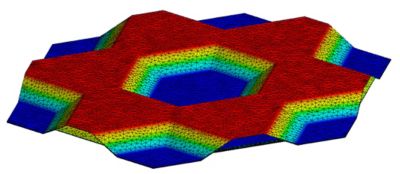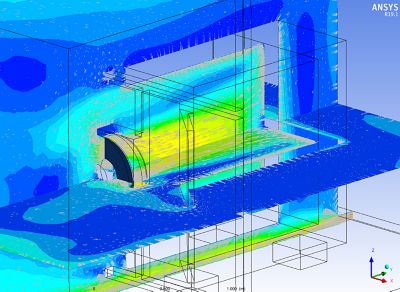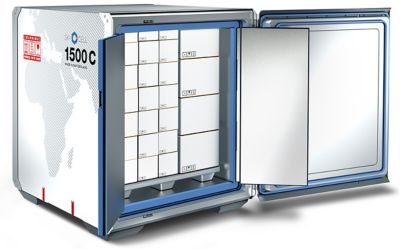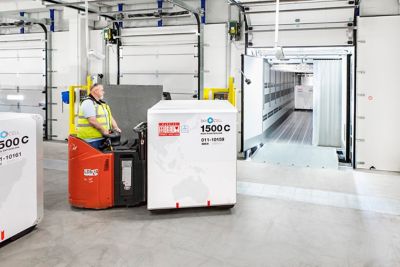-
United States -
United Kingdom -
India -
France -
Deutschland -
Italia -
日本 -
대한민국 -
中国 -
台灣
-
Ansys si impegna a fare in modo che gli studenti di oggi abbiano successo, fornendogli il software gratuito di simulazione ingegneristica.
-
Ansys si impegna a fare in modo che gli studenti di oggi abbiano successo, fornendogli il software gratuito di simulazione ingegneristica.
-
Ansys si impegna a fare in modo che gli studenti di oggi abbiano successo, fornendogli il software gratuito di simulazione ingegneristica.
-
Contattaci -
Opportunità di lavoro -
Studenti e Accademici -
Per Stati Uniti e Canada
+1 844.462.6797
ANSYS ADVANTAGE MAGAZINE
July 2021
Simulating Smart Containers Saves Lives
SkyCell saves lives by reducing vaccine shipment loss rate using Ansys simulation to design smart, IoT-enabled air freight containers.
By Ansys Advantage Staff
SkyCell designs, creates and manages smart, durable air freight containers for transporting vaccines across the globe. The containers are constructed with a bespoke material, require no direct human management, control their own temperature and report their location in real time. SkyCell uses Ansys HFSS, Ansys CFD and Ansys Mechanical to simulate a holistic view of Industrial Internet of Things (IIoT) components, air and energy flows, and the structural integrity of the container. Without simulation, it would be impossible for the team to aim for perfection in an industry that needs it, especially when lives are at risk.
Meeting the Challenges of Sensitive Cargo
Air freight containers are frequently in grueling conditions: spending hours on hot tarmac runways, subjected to bumpy aircraft landings and trucked via local roads. Vaccines have large molecules and are particularly sensitive to high and low temperatures, but temperatures in transit can easily vary from -20°C to +50°C, posing a challenge for logistics firms. On top of this, air freight is an expensive way to move goods, increasing plane traffic and pollution, but it’s crucial for vaccines to arrive quickly.
“Using Ansys software helps us to reduce the vaccine loss rate during shipping to just 0.1%. When the industry average for air freight containers is between 1% and 10% — and lives are very literally on the line — reducing this by a factor of a hundred has an incredible impact on human lives. Ansys’ software allows us to view the world in a more holistic way, designing a product that is far closer to perfection than other platforms can allow.”
— Nico Ros, CTO, SkyCell
A 3D thermal analysis in Ansys Mechanical showing the sub-model of container insulation with periodic boundary conditions
In air freight, it is common for 1% to 10% of a shipment to be lost or damaged, but SkyCell exists to reduce this to just 0.1%.
“Earlier this year, we had 4,000 coma patients in India waiting for a vaccine from Europe,” explains SkyCell CTO Nico Ros. “The pandemic had disrupted the supply chain, so the shipment was stuck in Qatar for five long, hot days. It eventually arrived in Mumbai, in perfect condition, despite the difficult conditions. This is just a regular day for us, and one of many situations that SkyCell was founded to tackle.”
Historically, air freight containers have either been active (refrigerant units) or passive (boxes filled with dry ice, for example) but SkyCell uses a hybrid design that doesn’t require human interaction or use mechanical components, and can recharge itself when it detects the steady 5°C conditions of a warehouse.
SkyCell’s hybrid design is a complex system of interactions. The team previously used separate simulation tools to model all aspects of the containers but knew that the design process could be significantly improved if they could model more holistically.
We needed a tool that could show us this complexity so that we could not only manage it, but also harness it to work in our favor,” says Ros.
Enhancing the container internal airflow in a pre-conditioning chamber with 3D CFD simulation in Ansys CFX
Engineering Solutions To Complex Problems
SkyCell worked with CADFEM as a strategic adviser to look at the simulation tools used by neighboring industries like aerospace and, after consideration, selected Ansys. The tools are used to simulate the physical structure, the IoT communications, and the air and temperature flows in and around the container.
“With Ansys, we could stop seeing the containers as refrigerators and start to understand the energy flows more precisely, like seeing the sun as an energy source rather than just thinking about temperature, for example,” says Ros. “Our approach is always to aim for perfection first and work backwards to what is possible. In theory, we could have used separate simulation tools for the first 80% of the design, but we wanted to build the Formula One car of air freight containers — something that will be vitally important when we have a vaccine for COVID-19. We simply couldn’t settle for anything less than the best.”
The SkyCell 1500 hybrid container has an internal temperature range of +2° to +8°C, an external conditions range of –35°C to +65°C, and a storage temperature range of –40°C to +70°C.
Saving Time And Lives With Simulation
Through the SkyCell team’s use of Ansys simulation, the vaccine loss rate when using SkyCell containers is currently just 0.1%, compared to the lower end of the industry average 1%.
It takes SkyCell three months to build a physical iteration of a container, but just one week to build it virtually using Ansys software. The relationship between the simulation and the test unit is continually refined.
“Our containers are built from a recyclable, insulated, multilayer, shock-absorbing material,” says Ros. “This material absorbs impact and dampens the vibrations from aircraft and trucks, but we had one example where the container frequency wasn’t quite optimized. We realized that there was an interaction between the layers of the material itself that we hadn’t picked up, but using Ansys we could remodel, correct and optimize this. A less sophisticated simulation tool simply wouldn’t have been able to cope with the complexity.”
Using Ansys to model the IoT components of the container allows SkyCell to accurately report its temperature and location in real time. This not only helps pharmaceutical companies to track the vaccines, but also to deal with transport regulations quickly because of the comprehensive data log, showing where the containers have been and how their temperatures have changed.
The SkyCell 1500 hybrid container in transit.
The system can also provide data on how quickly containers tend to pass through customs, identifying any unnecessarily slow parts of the route. This is vital in helping authorities and logistics firms to optimize their own transport networks and overcome local issues — or to help pharmaceutical companies ship to new areas for the first time, without mishaps.
“Looking to the future, we’ve estimated that the world will need approximately 160,000 pallets to transport a COVID-19 vaccine once it’s developed,” says Ros. “This is potentially double the number in existence, although this number will decrease if the system is efficient. Our mission is to help increase this efficiency, and once a COVID vaccine is developed, we’ll be proud to do our part.”
Cominciamo
Se devi affrontare sfide di progettazione, il nostro team è a tua disposizione per assisterti. Con una vasta esperienza e un impegno per l'innovazione, ti invitiamo a contattarci. Collaboriamo per trasformare i tuoi ostacoli ingegneristici in opportunità di crescita e successo. Contattaci oggi stesso per iniziare la conversazione.














